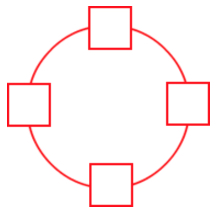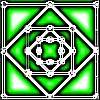Skip over navigation
Only one number is allowed in each square. You must use four different numbers.
What can you say about the sum of each pair of joined squares?
What must you do to make the difference even?
What do you notice about the sum of the pairs now?

Here .doc .pdf are some sheets for recording your solutions.


Or search by topic
Number and algebra
Geometry and measure
Probability and statistics
Working mathematically
Advanced mathematics
For younger learners
Ring of Numbers
Age 5 to 7
Challenge Level 





- Problem
- Getting Started
- Student Solutions
- Teachers' Resources
Ring a Ring of Numbers
Choose four of the numbers from this list: 1, 2, 3, 4, 5, 6, 7, 8, 9 to put in the four squares below so that the difference between joined squares is odd.Only one number is allowed in each square. You must use four different numbers.
What can you say about the sum of each pair of joined squares?
What must you do to make the difference even?
What do you notice about the sum of the pairs now?

Here .doc .pdf are some sheets for recording your solutions.
This problem is based on an idea taken from "Apex Maths Pupils' Book 2" by Ann Montague-Smith and Paul Harrison, published in 2003 by Cambridge University Press. To find out more about this book, and order a copy go to the CUP website.
Why do this problem?
This problem provides a context in which children can recognise odd and even numbers, and begin to think about their properties. It also offers practice of addition and subtraction.
Possible approach
It would be good to have the image of the 'ring' on the interactive whiteboard, or projected onto a screen. Begin by writing any four numbers in the ring and asking questions about them, for example:
- Which pair of numbers has a total of ...?
- Which pair of numbers has a difference of ...?
- Which pair of numbers has the highest/lowest total?
- Which pair of numbers has the greatest/least difference?
These questions will help children become familiar with the vocabulary of the problem and so you can then lead into the main activity. Having asked the question, give pairs of children chance to find at least one way of making odd differences. They could use this sheet of blank circles .doc .pdf to try out their ideas. As they find arrangements that work, you could invite them to record them on the board on some pre-drawn rings.
Once you have several ways on the board, invite learners to comment on what they notice. What do all the arrangements have in common? You can work through the rest of the problem in a similar way, drawing the whole class together as appropriate.
It is important to encourage the children to explain why the arrangements of odd/even numbers produce these results. You could make drawings .doc .pdf using paired joined squares to help them understand.
Key questions
What do you notice about the numbers in the ring when the difference between joined pairs is odd?
What do you notice about the numbers in the ring when the difference between joined pairs is even?
Can you explain why?
Possible extension
More Numbers in the Ring allows children to investigate different numbers of numbers in the ring.
Possible support
Some learners might benefit from having counters or other objects to help with their addition and subtraction.
You may also like
Homes
Six new homes are being built! They can be detached, semi-detached or terraced houses. How many different combinations of these can you find?
Number Squares
Start with four numbers at the corners of a square and put the total of two corners in the middle of that side. Keep going... Can you estimate what the size of the last four numbers will be?

